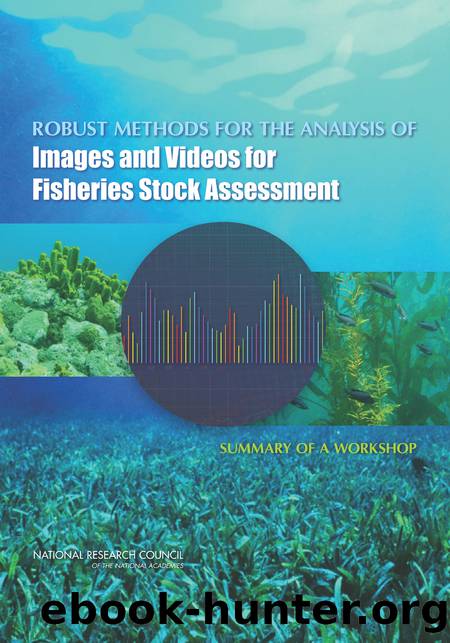Robust Methods for the Analysis of Images and Videos for Fisheries Stock Assessment: Summary of a Workshop by Maureen Mellody

Author:Maureen Mellody
Language: eng
Format: epub
Publisher: The National Academies Press
Published: 2015-03-03T00:00:00+00:00
MULTI-OBJECT MULTI-VIEW TRACKING
Margrit Betke, Boston University
Margrit Betke explained that she works with computer vision applied to the three-dimensional (3D) multi-object tracking and analysis of bat and bird flight. This is a collaborative effort that includes experts from geography, engineering, computer science, and biology. Betke specifically studies the Brazilian free-tailed bat, whose population may have dropped from 150 million to 11 million in the past 50 years (Betke et al., 2008). She noted that the Brazilian free-tailed bat acts as a pest control service, with each bat eating as many as 114 corn earworm moths in a single night, so there are economic as well as environmental reasons for desiring the bat to thrive.
Betke explained that she studies bats using thermal infrared cameras with a high spatial resolution at 131 frames per second. Using a three-camera system, she is able to develop 3D reconstructions of flight behavior. Her team has developed a protocol and calibration for multi-camera videography (Theriault et al., 2014). A calibration device with landmarks, which are easily identifiable because of their differing temperatures, is used to calibrate the space in which the bats are moving. After calibration, the two main elements to develop an objectâs trajectory are detection and tracking. Tracking can be further divided into both position estimation (which Betke indicated is fairly easy to accomplish) and data association/disambiguation (which Betke indicated is still quite difficult).
Betke explained that if bats are imaged at an observation distance of about 10 m, the resulting resolution is at least 10 pixels per bat. In the reported experiment, observation distances were chosen so that the reconstructed 3D positions had uncertainties less than 10 cm, the approximate length of a single bat; at a 10 m distance, the measured uncertainty in the 3D projection was 7.8 cm.
Betke explained that objects are tracked in 3D space with two-dimensional (2D) measurements through two possible methods of path reconstruction:
Reconstruction-tracking method. 3D positions are first reconstructed from multiple views, then a tracking approach is applied using feature-to-feature fusion. In other words, the correspondence of detected objects is found first across views, then across time.
Tracking-reconstruction method. 2D tracking in each view is applied independently, followed by the reconstruction of 3D trajectories through track-to-track fusion. In other words, the correspondence of detected objects is found first across time, then across views.
Download
This site does not store any files on its server. We only index and link to content provided by other sites. Please contact the content providers to delete copyright contents if any and email us, we'll remove relevant links or contents immediately.
| Fisheries & Aquaculture | Forests & Forestry |
The Lonely City by Olivia Laing(4753)
Animal Frequency by Melissa Alvarez(4400)
All Creatures Great and Small by James Herriot(4239)
Walking by Henry David Thoreau(3898)
Exit West by Mohsin Hamid(3779)
Origin Story: A Big History of Everything by David Christian(3652)
COSMOS by Carl Sagan(3561)
How to Read Water: Clues and Patterns from Puddles to the Sea (Natural Navigation) by Tristan Gooley(3411)
Hedgerow by John Wright(3280)
The Inner Life of Animals by Peter Wohlleben(3264)
How to Read Nature by Tristan Gooley(3256)
How to Do Nothing by Jenny Odell(3237)
Project Animal Farm: An Accidental Journey into the Secret World of Farming and the Truth About Our Food by Sonia Faruqi(3179)
Origin Story by David Christian(3149)
Water by Ian Miller(3131)
A Forest Journey by John Perlin(3029)
The Plant Messiah by Carlos Magdalena(2885)
A Wilder Time by William E. Glassley(2821)
Forests: A Very Short Introduction by Jaboury Ghazoul(2794)
